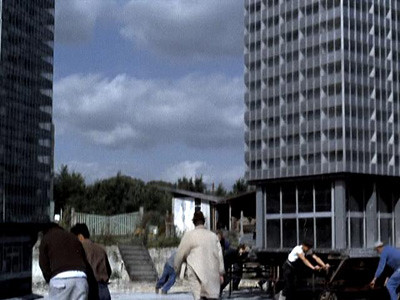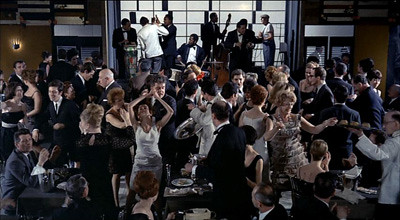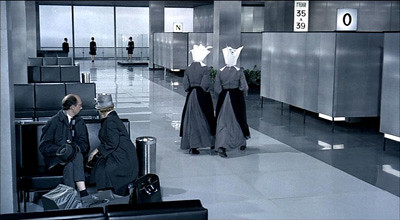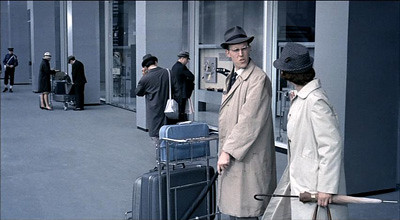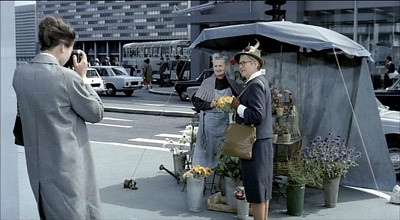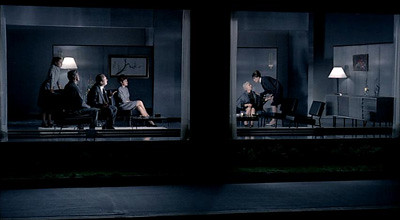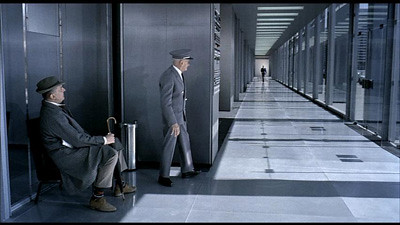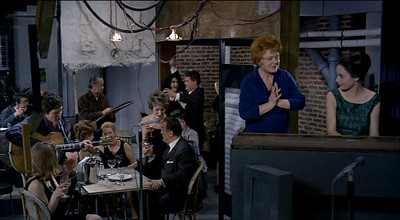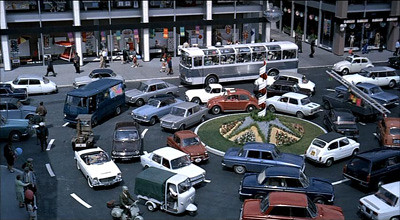Play Time, 1967, directed by Jacques Tati, written by Jacques Lagrange & Jacques Tati, with additional English dialogue by Art Buchwald.
One of my college professors summed up James Joyce's career by saying that Joyce mastered the short story, the novella, and the novel, in that order. Then, with no more worlds to conquer, he moved on to something else. And yet, despite that fact that it more or less invents its own art form, just about any passage chosen at random from Finnegans Wake is immediately recognizeable as Joyce. Play Time, Jacques Tati's marvelous film about modernity and its discontents, is Tati's "something else," a film that invents its own genre and visual language, yet is clearly the descendant of M. Hulot's Holiday and Mon Oncle. It is an essential film, an unimpeachable masterpiece, and you should see it immediately. If you've already seen it, see it again.
And as much as I love the Criterion Collection (and their Blu-Ray release is as good as you could hope for) you should find a way to see this film in a theater. There's a 70mm print that's been touring; track it down. Because I'm not kidding about Tati inventing his own visual language, and it is not well-suited for televisions (or, God forbid, telephones). Take a look at this shot, which is not atypical (clicking on the image will take you to a larger—but still much too small—version):
If you squint, you can almost make out M. Hulot shaking hands in the center of the frame. Obviously that sort of composition is going to look better on film than on TV, but it's not just because of the occasional long shot that I recommend first encountering this in a theater. Play Time was shot and edited in a style that I don't think I've ever seen before, which I would provisionally call "whatever the opposite of intensified continuity is." There are no close-ups at all, and hardly any medium shots. Hulot shaking hands is actually one of the easiest to read shots in the film, because there's nothing else going on in frame; this is rarely the case. In terms of visual information per square inch, most films are Pop Art. Play Time is the Raphael Rooms.
There's nothing in the image above directing your eyes anywhere, and there's detail everywhere. There are frames that crowded in lots of movies; I saw one over the weekend during the masquerade ball sequence in The Emperor's Candlesticks, of all things. But it was an establishing shot of the ball, probably less than three seconds long, and, most importantly nothing happened. The shot above lasts for twenty-one seconds, and over the course of that time, the following things happen, more or less simultaneously:
- In the foreground, a waiter crosses from left to right, attempting to deliver a platter of fish to the table in the lower right, but they don't seem to have ordered it.
- The red haired woman in the white dress can't... stop... doing the monkey.
- Another waiter, carrying an identical fish platter, crosses from right to left, stopping at the center front table to ask if they ordered it, but also asking random people on the dance floor. He nearly drops the fish when an American dancing with his wife bumps into the platter (you can see this happening in the still), but pulls it back in place by the tail.
- That same American, more or less dragging his wife across the dance floor, bawls out the waiter for trying to carry fish through the crowd, before dancing off to the right...
- ...which is too bad for his wife, who seems to be the one person who ordered the fish, because when she sees it she reaches out towards it and tries to get the waiter's attention, to no avail.
- The maître d' (the balding man in the tuxedo in the center of the still) works his way though the crowd and attempts to direct the two waiters with the fish...
- ...Which puts him directly in the path of the elderly waiter crossing from right to left with the tray of what look like rolls. With no way around him, the waiter basically pushes the maître d' offscreen to the left, using his tray to guide him.
- And that's just the foreground, because in the background, another waiter with the same goddamned fish platter attempts to deliver it to the band onstage before being waved off.
- And way in the back, a workman meanders onstage with a coil of cable he's running (the restaurant is still under construction), before being directed offstage.
All that happens in twenty-one seconds. Play Time is two hours, three minutes, and three seconds long. And maybe the fifth or sixth time you watch it, you'll notice that the workman in the background is played by Tati himself. This is why Gilbert Adair famously said that Play Time demanded repeat viewings from different seats in the theater. The idea behind virtually all film grammar is to direct the audience's attention towards whatever is most important in the frame. Tati isn't interested in this at all. In Play Time, as he told Jonathan Rosenbaum, his goal was to create "a democracy of gags," conflating the difference between foreground and background, main characters and extras. Anyone on screen can be doing something funny, at any time. Which, let's be honest, makes Play Time sound exhausting. But it isn't at all; it's glorious. For one thing, the shot above is late in the movie, towards the end of a long sequence in which the on screen energy is slowly and precisely ramped up. And Play Time, like most masterpieces, begins by teaching us how to watch it. Not counting the opening credits, here are the first three shots. The opening titles appear over a background of fluffy clouds, which are more or less wiped out by what I guess you'd have to call an establishing shot:
Next, we get a single-gag shot that basically serves as a reassurance that we're still in a Jacques Tati film.
As the two nuns walk down the hallway, their wimples flap like birds in flight. This is a joke that would be perfectly at home in M. Hulot's Holiday, and notice how simply it's staged: the nuns move from top left to bottom right; the hallway they're walking along is the only plane of action in the shot. Most importantly, there's only one joke on screen. This is intensified continuity: you know exactly where the director wants you to look, and if you hear anyone else in the theater laughing, you can be sure you're laughing at the same thing. And now we arrive at the shot where Tati throws intensified continuity out the window.
We track the nuns from the earlier shot as they enter from the left, make a ninety degree turn, walk away from the camera, then turn right and exit through the middle hallway on the right. The camera will stay completely still on this scene for the duration of the shot, one minute and forty seconds. There are three planes of entry on the left and four on the right, and Tati uses them all. But he starts off easy. The minute the nuns leave the frame (but not before) another character enters from the closest hallway on the right. Once he leaves (but again, not before), another character, another depth. We can trace their geometric paths up and down the hallway, or we can watch the bickering couple in the foreground; the camera isn't giving us any cues. Eventually, Tati has more than one person moving down the hallway at a once; a military officer, a short man with a coat thrown over his shoulders, a woman with a stroller.
The shot trains the viewer's eye to move freely around the frame, from the couple in the foreground to the women standing by the distant window. Tati isn't going to give us the kind of cues we expect from filmmakers. The effect, intentionally, is to make you watch the film the way you would watch passersby if you were really in that waiting area. By the time Tati finally cuts to a reverse shot, you can take your pick:
There's action on each of the three horizontal planes defined by the hallways. You can watch the man with the violin case, the military officer, the man with the towel wrapped around his head, or a man who appears to be M. Hulot, but if we look closely, is not. In fact, the film's opening scenes are filled with Hulot's dopplegangers; close enough to the real thing that an onscreen character spots Hulot's distinctive walk and stops him. Whereupon he turns.
Not only is he not Hulot, he's annoyed to have been mistaken for him. Hulot will be in this film, but he's not going to be the star. In fact, the genuine article doesn't appear until nearly ten minutes into the movie, trying to get off a bus with his umbrella entangled with that of one of his doubles.
So: no intensified continuity, no main character, long takes with nothing guiding the viewer's eye, but what is the film about, for God's sake? It has less of a plot than M. Hulot's Holiday (itself not a particularly plot-heavy film), but there are a few through-lines. Although dozens of characters appear and reappear throughout the film, Tati favors two: M. Hulot, in town to attend some sort of business meeting (perhaps the one he's sent off to at the end of Mon Oncle), and an American tourist, played by Barbara Dennek, visiting Paris. Where Mon Oncle showed a battle between old and new France, Play Time is set in a city where, to put it bluntly, the bums lost.
There's a great running joke where Barbara keeps catching glimpses of Parisian landmarks in the reflections of doors before getting herded back onto her tour bus and dragged off to some new glass monstrousity, but my favorite thing in the film are the posters in the travel agency she visits. (I would pay a great deal for a set of replicas, in fact). Click the image to get a good look at them:
Barbara does find one oasis of the Paris she came to see (and photograph), and here it is.
Hulot, in the meantime, utterly fails to keep his business appointment, tracking the man he's supposed to meet with through a warren of cubicles with his usual unflappable grace.
As with his earlier films, the plots exist only to bring the characters from one location to another. But unlike the lazy, wandering charm of M. Hulot's Holiday or Mon Oncle, Play Time actually does have a rigid structure. The odd, and I think unique thing, is that it is organized by theme rather than incident. Philip Kemp summarizes the plot as "how the curve comes to reassert itself over the straight line," and that's quite accurate. The opening sequences are all about people moving in rigid straight lines; living within the boundaries that modernity has laid out for them.
Hulot gets himself into trouble, but he doesn't manage to cause any real chaos the way he did in Mon Oncle. In the earlier film, Hulot posed a genuine threat to the Arpels' bourgeois respectability, but you get the sense that the architecture in Play Time is designed to absorb any resistence Hulot could possibly mount. Tati doesn't just allude to the way the inhuman scale of these buildings grinds the human soul to dust, he makes the audience experience it, too. Witness the excruciatingly long take of Hulot's business associate coming down the hallway to meet him.
The shot is one minute and fifteen seconds long, and a full forty seconds are spent waiting, with Hulot, for the man to walk down the entire length of the hallway. When he finally reaches us and we're expecting, at long last, something to happen, the man sizes Hulot up... and ushers him into a waiting room. It's like a Frederick Wiseman documentary about Camazotz.
One could imagine Lars von Trier producing a version of Play Time in which no one breaks free of their shackles, but Tati is an eternal optimist. So after about an hour of people failing to beat the system, both Hulot and Barbara end up at a restaurant called the Royal Garden, opening for its first night of business. It is just as hostile to human interaction as anything else in the film:
As in Mon Oncle and the first half of Play Time, humanity and architecture do battle, but this time architecture loses. This is, I think, one of the most perfect sequences in all of cinema. The editing and pacing are superb; Tati lets things build up so slowly you don't realize how manic it's gotten until you really pay attention to everything that's happening in a single shot. The first half of the film has several one-minute shots that seem to last about about an hour (on purpose!); the Royal Garden sequence is fifty minutes that feel like five. Eventually, Barbara, Hulot, and some of the other characters from the first half of the room manage to create something like a Parisian café in the wreckage of the restaurant; a smaller space for genuine human interaction.
When they finally emerge from the restaurant the next morning, the world is transformed around them. In Mon Oncle the lines of identical cars were a sign of conformity, but in Play Time Tati transforms them into a merry-go-round.
It's only at this point that Tati returns the colors that seemed to have been leached out of everything that's come before. The older world Hulot inhabits in the earlier films may not be coming back, but all is not necessarily lost. Play Time suggests there is human beauty in even the most austere modernist spaces. But we're going to have to fight for it.
Randoms
- Unfortunately, (and again, like Finnegans Wake), the production of Play Time was a multi-year debacle. Filming took nearly three years, the budget was spent many times over, Tati was financially ruined, and in the end, it was released to indifferent critical response and didn't even get distribution in the United States. Tati seems to have been fairly equanimous about the relationship between financial and artistic success, however. At a Q&A after the film's 1972 U.S. premiere at the San Francisco International Film Festival, someone asked him, "How much did it cost to make Play Time and how was it received in Europe, artistically?" (I love the tacked-on second part of the question). His answer, even in less-than-perfect English, is definitive:
Well, first, I will give you the address of the people who finance the picture—I came here on the artistic point of view, I didn't come on the business point of view. The only thing I can tell you, that I had a house before Play Time, I don't have my house today. So you can understand what kind of balance is between the picture, the finished picture. But I don't think it's very important. Or—that's what I feel, you asked me a question—or you have the respect of the young generation in my age—that's what I think I have, I've seen it here—or you have the respect of the Banque de France. It's a choice.
- Nothing in this essay shoud be construed to imply that any redeeming vestiges of humanity will ever be found in Government Center. Let's not kid ourselves.
- Except for Paris-Orly Airport, all of the locations were built for the film; an entire city block as well as several miniatures for forced perspective shots. One of the original plans to finance Play Time was to build actual office buildings instead of sets, and sell them after production was finished; that didn't work out, and the entire set was destroyed shortly after production. You can get a good look at two of the miniatures in Cours du Soir, a short film partially shot on the set of Play Time. There's a wonderful shot of buildings parting like the Red Sea for Hulot to pass on his way to a run-down shack.
